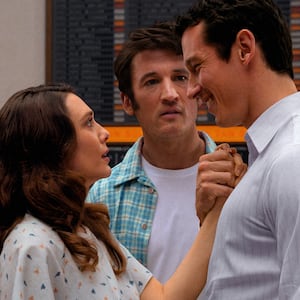In The Smashing Machine, Dwayne “The Rock” Johnson dons facial prosthetics to play a pro fighter whose thoughtful, kind, patient disposition is the exact opposite of the star’s brash, antagonistic, trash-talking WWE persona.
Nonetheless, the wrestler-turned-actor can’t fully disappear into the role of Mark Kerr, an early ultimate-fighting pioneer, as the film’s fixation on his gargantuan physique, when coupled with a paper-thin script, calls incessant, distracting attention to his real-life identity. With nothing lurking beneath his character’s brawny exterior, and even less to his up-and-down tale, Johnson proves merely an adequate contender in his bid for dramatic credibility, incapable of transforming this hollow sports biopic into a knockout.
Helmed by Benny Safdie (who won the best directing prize at the Venice Film Festival) with handheld camerawork that bobs, trembles, and persistently shifts its gaze between Kerr’s hands and face, The Smashing Machine—screening at the Toronto International Film Festival—barely has a story.
What suffices for one involves Kerr’s success in the pre-UFC ring in the States and overseas, his relationship with girlfriend Dawn Staples (Emily Blunt), and his struggles with substance abuse. As befitting the material’s shallowness, the specific narcotics that Kerr fancies are left vague; there are only brief mentions of opioids and painkillers, as well as sights of tiny vials filled with clear liquid. Similarly, when Kerr has a near-death episode thanks to his habit, it’s kept off-screen and only discussed in the past tense, the better to keep things simple and easily digestible.
At every juncture, The Smashing Machine pulls its punches, and that’s truest when it comes to presenting a three-dimensional portrait of its protagonist—and, relatedly, concocting a reason to care about his saga. In credit-sequence narration married to footage of his initial victories in 1997 São Paulo, Kerr—who speaks in a soft and measured tone that suggests he’s carefully considering what he’s saying—states that “winning is the best feeling there is.”
Later, a reporter in Japan, where many of his bouts take place, asks him what it would feel like to lose, and the concept is so foreign to him that he barely manages an answer (“If I lost, I don’t know how to respond”), thereby foreshadowing the crisis of confidence on the horizon.
Kerr is such an unstoppable goliath that the prospect of vulnerability appears to be the biggest threat to his career and life, aside, that is, from Staples, whose big hair and cleavage-baring tops immediately mark her as trouble.
Their hostile pre-match locker room spat, which sends fellow fighter and Kerr’s best friend Mark Coleman (Ryan Bader) hurrying to the exit, is a bad omen. Sure enough, their relationship is a volatile mixture of lovey-dovey Phoenix domesticity and heated scraps in which he takes out his anger on a door (obliterating it with his bare hands) and she smashes the bowl he purchased for her in Tokyo.
Theirs is a standard-issue unhealthy relationship, with Kerr prioritizing his training and fights ahead of everything else (save for getting totally zonked on drugs), and Staples pushing her beau’s buttons with needy, manipulative selfishness.
Kerr tells Staples that the high he gets from pounding dudes’ faces is “orgasmic,” so when he finally stumbles in the ring, he’s badly shaken, and the fact that he was bested due to illegal maneuvers on his opponent’s part—resulting in a “no-contest” decision that still stings like a loss—exacerbates his agony.
The root cause of the grappler’s hang-ups, however, are ignored by The Smashing Machine. Safdie mercifully avoids providing the types of explanations for Kerr’s issues (abusive fathers, absent mothers, childhood bullying, etc.) that are the stock and trade of Hollywood biopics. Yet he doesn’t offer up anything in their place. Consequently, the man comes across as just a gargantuan combatant with a patient demeanor, a ferocious temper, and an inclination to do self-destructive things in service of his dreams.
The Smashing Machine doesn’t depict Kerr as an ultimate-fighting legend; aside from the film’s first few minutes, he fails in the ring as much as he succeeds. Nor does it cast him as a complicated individual whose story has something to impart about competition, sacrifice, or the zig-zagging line separating love and hate.
Kerr’s battle with addiction is also simply an addendum, since Safdie skips over his process of getting clean, assuming that a single phone call to a sponsor (which Staples uses as an excuse for picking on him) will suffice. The real drama is almost always recounted rather than shown, whereas irrelevant incidents—like a 2000 tournament introduction featuring an electric guitarist playing the Japanese national anthem and a harpist singing “The Star-Spangled Banner”—are dwelled on to excessive ends.
Johnson doesn’t overdo it as Kerr, to a fault; while the man is a nice enough guy, good-naturedly defending ultimate fighting with a grandmother in a doctor’s waiting room, cheering on Coleman as he goes on a remarkable in-ring run, and helping his coach deal with an unspecified physical malady by injecting him with life-saving narcotics, his is a basic story of accepting imperfection in himself and others.
Safdie’s direction affects faux-verité authenticity but it has none of the gritty urgency of his collaborations with brother Josh (Heaven Knows What, Good Time, Uncut Gems). Instead, his style is just a pose designed to conceal the proceedings’ emptiness and lethargy, the latter of which is most pronounced during a climactic fight montage that drags at the very moment the film needs to soar.
Whenever Kerr begins heading down an ill-advised path, Nala Sinephro’s score breaks into bluesy saxophone—a groan-worthy touch that’s indicative of The Smashing Machine’s calculations. After falling short in its quest for poignant uplift, Safdie’s film indulges in the hoary non-fiction coda that is as ho-hum and unenlightening as the primary action seems, depressingly, apt.









